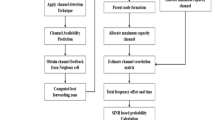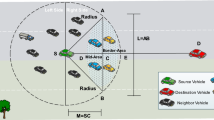Abstract
In Vehicular ad-hoc networks (VANETs), resource allocation has become one of the primary tasks. Thus, a system should be well-designed so that information could be transmitted reliably and efficiently. As vehicular communication has several characteristics, efficient resource allocation scheme for D2D communications is highly required in VANET. The network topology changes rapidly as the vehicles are moving fast on the road and this makes it harder to communicate among the vehicles by predicting the best available channel. So as to overcome these issues, the proposed technique is offered in which the channel availability is predicted based on the novel mechanism like contention latency prediction using interframe spaces like Short interframe space, Distributed Coordination Function interframe space, Pointed Coordination Function and scattering based greedy weight matrix method. The implementation of this greedy mechanism in turn enhances the prediction probability of best channels that are available. Thus, the best available channel offered using greedy weight matrix scheme thereby estimates the decision probability at which the collision for available channel is computed. Thus, from this the best available channel is provided to the requested user. At last, the performance analysis is made in terms of packet delivery ratio, throughput, delay, reliability, and rate of message loss and is compared with existing techniques to prove the effectiveness of proposed strategy.















Similar content being viewed by others
References
Lyu, F., Zhu, H., Zhou, H., Qian, L., Xu, W., Li, M., et al. (2018). MoMAC: Mobility-aware and collision-avoidance MAC for safety applications in VANETs. IEEE Transactions on Vehicular Technology, 67, 10590–10602.
Pal, R., Prakash, A., & Tripathi, R. (2018). Triggered CCHI multichannel MAC protocol for vehicular ad hoc networks. Vehicular Communications, 12, 14–22.
Zhang, H., Wang, Z., & Liu, K. (2020). V2X offloading and resource allocation in SDN-assisted MEC-based vehicular networks. China Communications, 17, 266–283.
Rana, K. K., Tripathi, S., & Raw, R. S. (2018). Analytical analysis of improved directional location added routing protocol for VANETS. Wireless Personal Communications, 98, 2403–2426.
Aslani, R., Saberinia, E., & Rasti, M. (2020). Resource allocation for cellular V2X networks mode-3 with underlay approach in LTE-V standard. IEEE Transactions on Vehicular Technology, 69, 8601–8612.
Li, D., Xu, S., & Li, P. (2021). Deep reinforcement learning-empowered resource allocation for mobile edge computing in cellular V2X networks. Sensors, 21, 372.
Jameel, F., Khan, W. U., Kumar, N., & Jäntti, R. (2020). Efficient power-splitting and resource allocation for cellular V2X communications. IEEE Transactions on Intelligent Transportation Systems. https://doi.org/10.1109/TITS.2020.3001682
Sulistyo, S., & Alam, S. (2017). Distributed channel and power level selection in VANET based on SINR using game model. International Journal of Communication Networks and Information Security (IJCNIS), 9, 432–438.
Rehman, O., & Ould-Khaoua, M. (2019). A hybrid relay node selection scheme for message dissemination in VANETs. Future Generation Computer Systems, 93, 1–17.
Rehman, O., Ould-Khaoua, M., & Bourdoucen, H. (2016). An adaptive relay nodes selection scheme for multi-hop broadcast in VANETs. Computer Communications, 87, 76–90.
Boussoufa-Lahlah, S., Semchedine, F., & Bouallouche-Medjkoune, L. (2018). Geographic routing protocols for Vehicular Ad hoc NETworks (VANETs): A survey. Vehicular Communications, 11, 20–31.
Hu, H., Lu, R., Huang, C., & Zhang, Z. (2017). PTRS: A privacy-preserving trust-based relay selection scheme in VANETs. Peer-to-Peer Networking and Applications, 10, 1204–1218.
Er-rouidi, M., Moudni, H., Faouzi, H., Mouncif, H., & Merbouha, A. (2017). A fuzzy-based routing strategy to improve route stability in MANET based on AODV. In International conference on networked systems, pp. 40–48.
Kasana, R., Kumar, S., Kaiwartya, O., Kharel, R., Lloret, J., Aslam, N., et al. (2018). Fuzzy-based channel selection for location oriented services in multichannel VCPS environments. IEEE Internet of Things Journal, 5, 4642–4651.
Zhu, J., Wang, T., Li, K., Fang, W., & Zhang, W. (2018). Content-based download cooperation scheme in VANET: A brief review. In FSDM, pp. 365–373.
Wei, M., & Kim, K. (2016). An automatic test platform to verify the security functions for secure WIA-PA wireless sensor networks. International Journal of Distributed Sensor Networks, 12, 1550147716676094.
Zeng, F., Zhang, R., Cheng, X., & Yang, L. (2017). Channel prediction based scheduling for data dissemination in VANETs. IEEE Communications Letters, 21, 1409–1412.
Agballa, U., Obiniyi, A., & Ayeni, B. (2019). Design of an improved energy efficient routing protocol in VANET using a modified route-optimal path algorithm. In Reason, Vol. 12.
Abada, D., Massaq, A., Boulouz, A., & Salah, M. B. (2020). An adaptive vehicular relay and gateway selection scheme for connecting VANETs to Internet via 4G LTE cellular network. In Emerging technologies for connected internet of vehicles and intelligent transportation system networks (pp. 149–163). Springer.
Oche, M., Tambuwal, A. B., Chemebe, C., Noor, R. M., & Distefano, S. (2018). VANETs QoS-based routing protocols based on multi-constrained ability to support ITS infotainment services. Wireless Networks, 26, 1685–1715.
Rashid, S. A., Audah, L., Hamdi, M. M., & Alani, S. (2020). Prediction based efficient multi-hop clustering approach with adaptive relay node selection for VANET. Journal of Communications, 15, 332–344.
Almohammedi, A. A., Noordin, N. K., Sali, A., Hashim, F., & Balfaqih, M. (2017). An adaptive multi-channel assignment and coordination scheme for IEEE 802.11 P/1609.4 in vehicular Ad-Hoc networks. IEEE Access, 6, 2781–2802.
Abbas, G., Abbas, Z. H., Haider, S., Baker, T., Boudjit, S., & Muhammad, F. (2020). PDMAC: A priority-based enhanced TDMA protocol for warning message dissemination in VANETs. Sensors, 20, 45.
Gamal, M., Sadek, N., Rizk, M. R., & Ahmed, M. A. E. (2020). Optimization and modeling of modified unslotted CSMA/CA for wireless sensor networks. Alexandria Engineering Journal, 59, 681–691.
Du, J., Wang, S., & Zhang, B. (2020). Vehicle density and signal to noise ratio based broadcast backoff algorithm for VANETs. Ad Hoc Networks, 99, 102071.
Author information
Authors and Affiliations
Corresponding author
Additional information
Publisher's Note
Springer Nature remains neutral with regard to jurisdictional claims in published maps and institutional affiliations.
Rights and permissions
About this article
Cite this article
Grace Shalini, T., Jenicka, S. Weighted Greedy Approach for Low Latency Resource Allocation on V2X Network. Wireless Pers Commun 119, 2303–2322 (2021). https://doi.org/10.1007/s11277-021-08332-3
Accepted:
Published:
Issue Date:
DOI: https://doi.org/10.1007/s11277-021-08332-3




